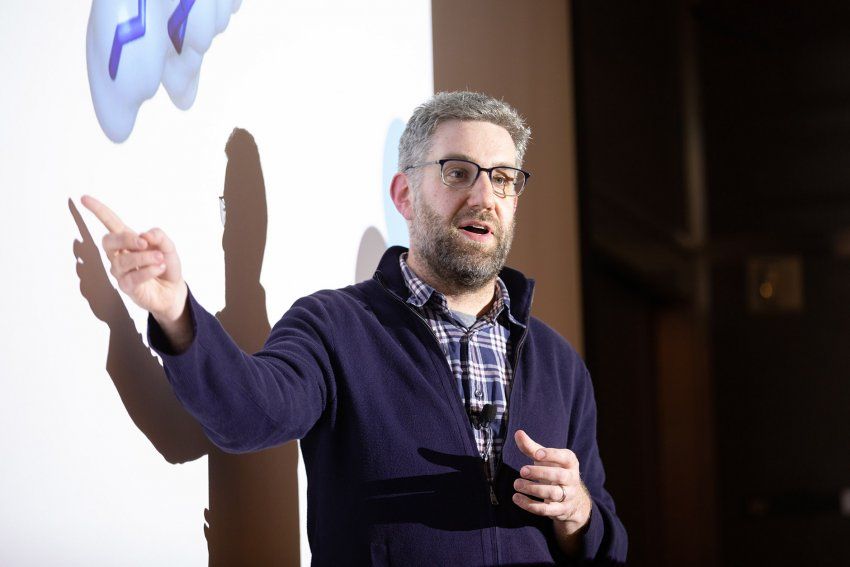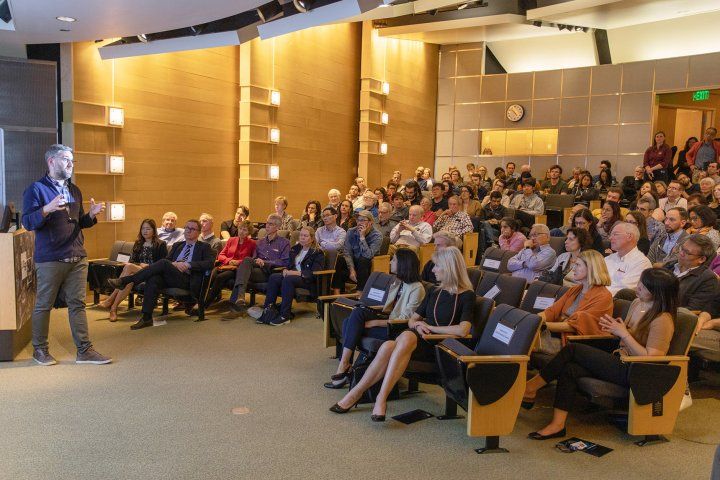James Fraser Delivers 2020 Byers Award Lecture on the War Against Antibiotic-Resistant Infections

James Fraser, PhD, delivers the 2020 Byers Award Lecture in Basic Science, a talk titled “A Song of Ice and Fire: Visualizing Macromolecules Using Cold Electrons and Hot X-Rays.” Photo by Sonya Yruel
An “obsession” with filming macromolecules in their watery cell environments has given structural biologist James Fraser, PhD, an up-close and personal look at how to wage war against antibiotic-resistant infections that kill an estimated 700,000 people a year worldwide.
Fraser demonstrated how providing precise moving pictures of macromolecules – the building blocks of cells – will help scientists develop drugs to disarm the bacteria that have become highly skilled at thwarting drugs designed to kill them before the infections they cause kill us.
Spoiler alert: Humans are losing. According to the U.S. Centers for Disease Control and Prevention, almost 3 million antibiotic-resistant infections occur in the United States every year, and more than 35,000 people die as a result. Reasons include over-prescription of antibiotics, overuse of antibiotics in livestock and patients who fail to take an entire course of antibiotic treatment.
Fraser discussed science’s evolutionary arms race against bacteria when he delivered the 2020 Byers Award Lecture in Basic Science on March 3 in a talk titled “A Song of Ice and Fire: Visualizing Macromolecules Using Cold Electrons and Hot X-Rays.” Also a biophysicist and the 2019 Bowes Biomedical Investigator, Fraser joined UCSF in 2011 from UC Berkeley and is currently an associate professor in the School of Pharmacy’s Department of Bioengineering and Therapeutic Sciences.

This year marked the 25th anniversary of the Byers Award Lecture in Basic Science. Photo by Sonya Yruel
The Byers Award, established with a philanthropic gift from Brook and Shawn Byers and their family, is given annually to recognize outstanding research by a mid-career faculty member. Philanthropist Brook Byers described the lecture as his family’s Academy Awards. “It’s Oscar day for us,” he said. “For 25 years now, we’ve seen the good work that these fantastic scientists are doing to move science forward. Becoming part of the UCSF community opens up portals of intellectual curiosity, answers to all kinds of questions, and also friendships. We are honored to be here.”
UCSF Chancellor Sam Hawgood, MBBS, the Arthur and Toni Rembe Rock Distinguished Professor, called Byers a loyal friend, as well as a “very active member” of the UCSF Foundation since 1987. “Brook has brought his generosity, his wisdom, and his experience to our scientists,” the chancellor said. “He has been truly instrumental to where we are today in science at UCSF.”
Fraser proved to the packed audience at Byers Auditorium just why a picture is worth 1,000 words by showing a still photo from a video of his two young sons in which the older boy appears to share a toy truck with his little brother. Then, the crowd learned what really happened when Fraser rolled the film: No sharing occurred. The older child actually took the truck from the toddler, causing the younger one to topple backward.
“The movie tells a different story,” Fraser said, as he explained his “obsession” with filming how macromolecules interact within their cells so scientists can see exactly how to create small-molecule drugs that effectively kill bacterial cells. Offering a crash course in biological medicine, Fraser explained that antibiotics work by halting a bacteria’s efforts to make new proteins necessary for its survival. Given that a bacteria will try “with its dying breath” to outmaneuver the antibiotic by modifying itself, scientists must stop the modification before it occurs.
“In experiments thus far, we have identified two compounds that can kill nonresistant bacteria and – excitingly for the first time – also kill the resistant bacteria,” he said, adding that the work is a result of a team effort that includes Ian Seiple, PhD, an assistant professor at the UCSF Cardiovascular Research Institute.
“We are finding new directions for optimizing antibiotics by understanding the whole cycle of how a protein is produced,” Fraser said. “This work, which was funded by a PBBR (Program for Breakthrough Biomedical Research) award, has moved really fast.”
Hawgood paid tribute to the founders of PBBR, late philanthropists Herb and Marion Sandler, who established the program 20 years ago that is now celebrated annually with the Byers Award Lecture. The chancellor noted that the 2020 lecture is the first without the presence of Herb Sandler, who died last June. But a video featuring the generous philanthropist left no doubt about his strong belief in the program.
“We are here to take risks with the best and the brightest,” Mr. Sandler says in the film. “We have unleashed creativity. That’s what our funding in science is all about. If you are dealing with highly intelligent people who can carry through ideas and who have what it takes to make them come to fruition, that’s where the big change takes place. I mean, that’s what life is all about, for God’s sake.”